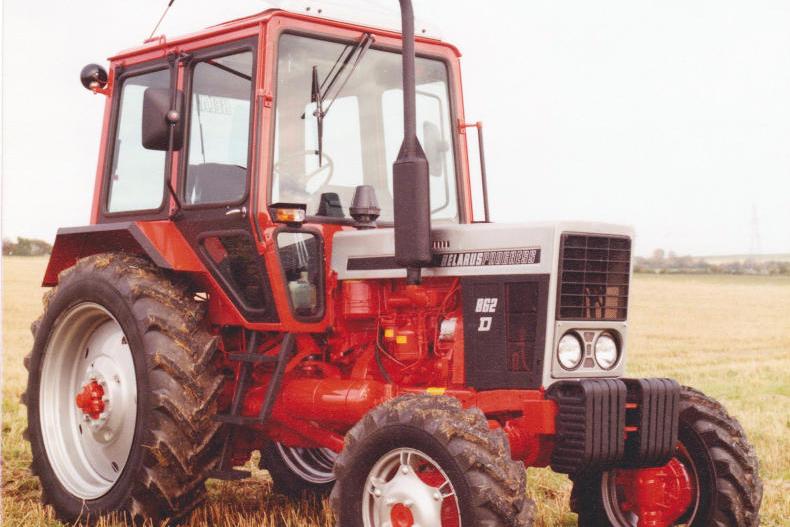Few tractor brands have survived against the odds as much the Belarus range and it continues to be sold in the Irish market 45 years after its first introduction. This eastern European tractor range was first seen at the 1971 Smithfield Show in London. That year also marked the influx of a range of eastern European tractors such as the Universal built under a Fiat licence in Romania.
The prices for new tractors in Britain and Ireland had increased significantly and that was prompting dealers and importers to look at other options. While these eastern European tractors were price-competitive in terms of horsepower, they lacked the hydraulic and power-take-off performance of some of the British- and Continental-built tractors of the time.
Entering the scene
The introduction of the Belarus tractor range into Ireland was a little different to that of other tractor ranges. That was probably not a surprise as these were times of the Cold War and trade between east and west Europe was far from easy.
For the Irish market, the Belarus company, which claimed to be the largest producer in numbers of tractors in the world at the time, chose an insurance company that had evolved into Private Motorist Protection Association (PMPA) as its importer. PMPA was started in the 1950s in response to high insurance costs and soon diversified into car garages and tractor sales.
Around 1971, the PMPA group began selling the Belarus tractor range from a large distribution centre it had on Dublin’s Long Mile Road where it traded as PMPA Farm Machines Ltd. The company was also the Irish agent for the British Hymac excavator range, as well as German Zettlemeyer loaders, having taken over McCairn’s Motors in Santry, Dublin.
The Belarus tractors sold through the network of 34 PMPA garages, which were dotted across the country. They were demonstrated on farms around the country in January of that year, but they still failed to make a big impression on the market even though they were price competitive.
In action
I recall as a young teenager cycling from Galway to Oranmore to see one of those demonstrations at Derrydonnell Cross, where to my delight the PMPA team allowed me the pleasure of driving the MTZ52 tractor with a four-furrow plough attached. Farmers turned out in the hundreds to see the ‘‘cheap’’ Russian-built tractors in action, but sales were slow. The tractors were sold on the basis that they were strong enough to withstand the Russian winter.
There were four models in the range at that time, the MTZ50, 52, 40 and 40A. The A meant that the tractor was a four-wheel-drive model while the MTZ52 was also the four-wheel-drive variant.
The 57hp 40 Series models were powered by a four-cylinder air-cooled engine. The larger 50 Series tractors were powered by a water-cooled engine and were rated at 70hp. They were both fitted with safety cabs as standard and prices ranged from £2,278 for the entry model two-wheel-drive MTZ40 to £3,197 for the MTZ52 Super. A John Deere tractor at that time cost almost double.
These tractors were crude in design but not in features. They were fitted with an automatic four-wheel-drive system that engaged on wheel slip. They came with independent disc brakes; still a novelty at the time, power-assisted steering, front-axle suspension and a two-speed power take-off.
The front- and rear-axle widths could be easily adjusted. There was a screw type adjustment for the front axles that was easy to use. The Belarus tractors were fitted with a 100-litre capacity fuel tank, which was large for that time.
The latest figures from the 2015 Irish Bulletin of Vehicle Statistics shows that there are 121 Belarus tractors listed as paying annual road tax in Ireland out of a total pool of more than 83,000 tractors. Kilkenny has the highest population of Belarus tractors, probably due to the fact that Belarus Equipment Ireland, a former Belarus importer, operated from Kilmacow on the Kilkenny-Waterford border for more than 20 years.
Today, after many importer changes, Belarus tractors are imported by a new company called Minsk Tractor Plant Ltd, Dublin Road, Kilmacow, Waterford.
The history
Belarus began tractor production in 1946 after World War II at the site of a former aircraft maintenance works on the outskirts of Minsk in the Belarusian state. The first plan was to produce tracked-type tractors and this was replaced with rubber-tyre tractors in the mid-1950s.
By 1956, Belarus was producing 10 tractor models. By 1958, it had produced its 100,000th tractor. The big step forward came in 1961 with the introduction of the MTZ50 model, which was rated at 55hp.
By 1972, the Minsk tractor factory had produced one million tractors, some of which were finally assembled at factories in Poland, Pakistan, Russia and Azerbaijan in addition to Minsk. This impressive output continued until 1984 when it reached a two-million tractor milestone.
During the Cold War, Belarus tractors sold in western markets were infamous for their low quality compared with western manufacturers.
After the fall of the Berlin Wall in 1989, the inability to build tractors in eastern Europe came to symbolise the failure of communism. Many tractor factories could not obtain quality materials and used inferior components. The quality of rubber seals, gaskets and paint was particularly poor in the early 1990s. The Belarus name suffered much during this time.
Since 2000, there has been more investment in the Belarus business and the name has bounced back with larger tractors and more technology to meet the demands of the European and north American markets.
Belarus tractors are still being produced today in smaller numbers with output still quoted at an impressive 80,000 tractors per year.







SHARING OPTIONS